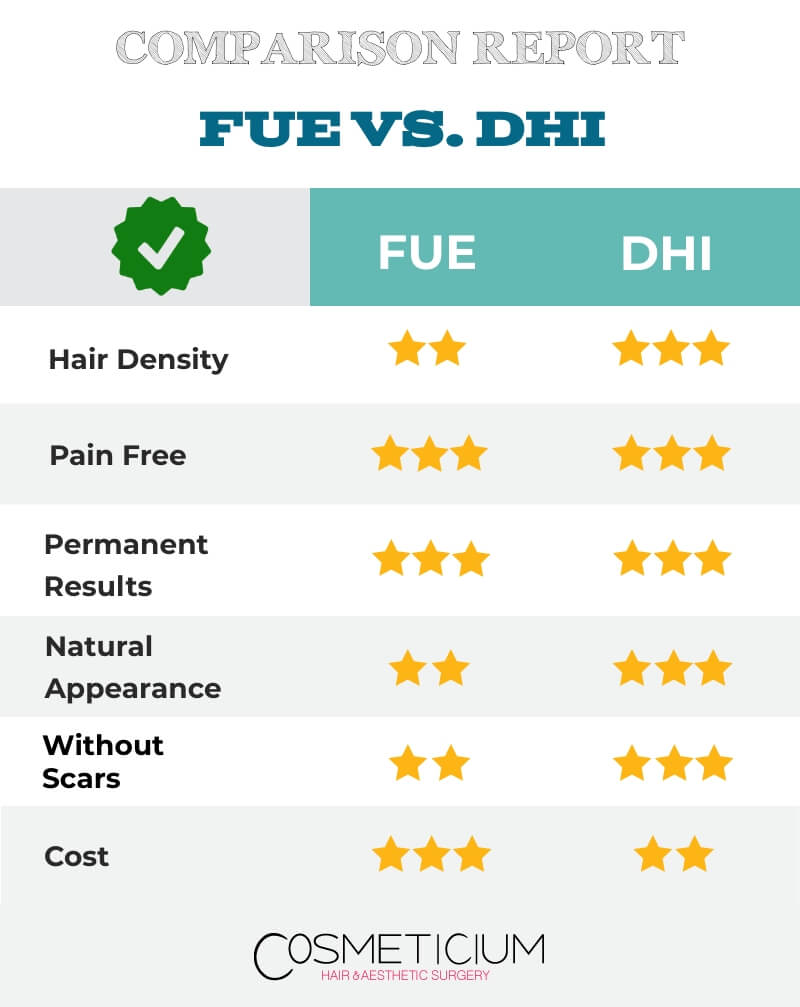Different hair transplantation techniques have been developed to meet the needs of people. Today, some of these techniques are more preferred. Depending on the expectation, hair transplantation techniques to be preferred may also differ. However, it would not be wrong to say that the most preferred ones are FUE and DHI techniques. In the rest of our article, we will give comprehensive information about the most suitable hair transplantation techniques, DHI and FUE and we will compare them.
FUE Hair Transplantation Technique
FUE is one of the most preferred technique for those looking for the most suitable hair transplantation method. In this technique, grafts are collected one by one from the donor area. Then, special canals are opened on the area to be transplanted. These canals are not opened randomly, but in an order and at a certain angle. Thus, the result is ensured to be similar to natural hair. Finally, grafts collected earlier are placed in these opened canals. Thus, the process is completed. This particular method has many advantages in itself. However, although not many, it should be known that there are some disadvantages too. These can be listed as follows:
Table of Contents
Advantages:
- Although it is a surgical procedure, it does not involve scalpel and suture.
- It can be applied to men and women.
- There is no scar left on the application area.
- Provides a natural appearance.
- The healing rate is high and this allows patients to return to daily life in a short time.
- It can be used for beard, eyebrow, and mustache transplantation.
- It is possible to transplant between 2,500 and 3,000 grafts in one session. This is usually sufficient.
- Transplantation can be done with hair strands taken from different areas.
Disadvantages:
- The procedure time is longer than some techniques.
- Not collecting the grafts carefully and meticulously from the donor area may cause different problems.
- It may not be a suitable method for everyone. (Not suitable for those with chronic and serious illnesses.)
Although the FUE technique has some drawbacks, it is known that it meets the expectations to a great extent. It can be considered as the most widely performed method in the world at the moment.
You May Also Like: When & How To Shave After Hair Transplantation?
DHI Hair Transplantation Technique
It is one of the recently developed hair transplantation techniques. If you want more intense hair transplantation, the most suitable technique is DHI. In this technique, hair grafts are also collected one by one. Then they are transferred into a special tool known as the DHI pen. With this pen, transplantation is performed to the balding area at the desired angle. Thanks to the pen, there is no need to open an extra canal. Canal opening and transplantation of the hair grafts are done at the same time. Thus, the collected grafts stay outside for a very short time and the procedure is completed without them losing their function. This situation increases the success of the procedure. The DHI hair transplantation technique has its pros and cons. It is possible to list them as follows:
Advantages:
- It is a procedure that results in much less pain and bleeding.
- Operation success is very high.
- More intense transplantation can be done compared to other techniques.
- There is no scar left.
- The use of a scalpel and suture is not an option.
- Hair follicles are directly implanted, thus minimizing the time spent outside.
- It prevents existing hair from being damaged.
- In a single session, 2 specialist doctors can work together to transplant up to 5500 grafts in total.
Disadvantages:
- It is a longer procedure. Depending on the number of grafts to be transplanted, in some cases, more than one session may be needed.
- It is relatively a more expensive method. (By 15-20%)
- The number of grafts transplanted in a single session is less than other techniques.
You May Also Like: How Much Does DHI Hair Transplant Cost?

Differences Between DHI and FUE
We talked about the 2 methods about the most suitable hair transplantation techniques. Now, let’s talk about their differences. DHI and FUE are techniques that meet expectations at a very high level. However, there are some differences between these techniques. The differences between DHI and FUE and the consequences resulting from them are as follows:
- In the FUE technique, canals are opened with a cutting tool. These canals should be slightly larger than the diameter of the grafts for easy hair transplantation.
- In the DHI technique, there is no such process as canal opening. Therefore, much more intense hair transplantation can be done.
- The placement of the grafts is made with a tool known as forceps in the FUE technique.
- In the DHI technique, grafts are placed with a tool known as CHOI-PEN. This tool also provides the canal opening.
The graft collection procedure is the same in FUE and DHI techniques. However, the preferred methods for their transplantation are different. The main difference between the two techniques lies here.
CONCLUSION
We mentioned above all the details about DHI and FUE. Based on the features and differences of the techniques, you can now determine which hair transplantation technique is the most suitable for you. There isn’t a single perfect technique for everyone. For some, the FUE technique and for others the DHI technique may be more appropriate. At this point, it will be much more appropriate to decide after the consultation with your doctor.

![What is the Best Hair Transplantation Technique for You? [DHI vs. FUE]](https://cosmeticium.com/wp-content/uploads/2020/09/What-is-the-Best-Hair-Transplantation-Technique-for-You.jpg)